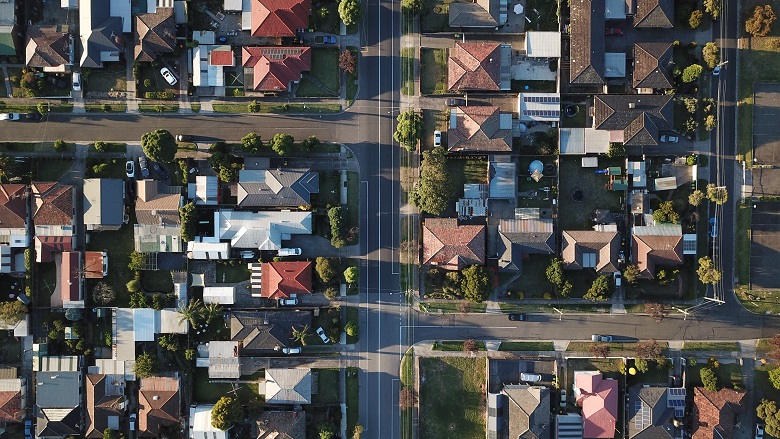The HSI series offers a forward-looking view by analysing actual customer behaviour from CBA’s transactions data, along with household spending search activity from Google Trends. This combination adds to insights on prospective household spending trends in the Australian economy.
Home buying spending intentions in October improved marginally as home loan applications rose, while travel spending intentions were flat – albeit expected to improve as state borders open up.
Mr Halmarick confirmed that some weakness was evident in health & fitness, education and motor vehicle spending intentions, all led lower by a decline in online search activity.
“Notwithstanding this mixed result, other data points to an improvement in the Australian economy in the early stages of November.
“Spending on CBA credit/debit cards has picked up as the Victorian economy opens up. In addition, low interest rates are encouraging an increase in home loan applications, especially for fixed rate mortgages by owner-occupiers. A stronger housing market should support spending intentions in the months ahead – as should the recent significant easing of monetary policy by the Reserve Bank of Australia,” said Mr Halmarick.
Read the latest Household Spending Intentions report.
You can also read our economic team's latest profile for Gross Domestic Product (GDP).
Monthly Household Spending Intentions – October 2020

Each month, analysis by CBA’s Global Economic and Markets Research team provides an early indication of spending trends across seven key household sectors in Australia. In addition to home buying, the series covers around 55 per cent of Australia’s total consumer spend across; retail, travel, education, entertainment, motor vehicles, and health and fitness.
Retail Spending Intentions
- While there were some increases in retail spending intentions in the month of October, the annual pace of retail spending intentions continued to soften.
- The impact of the Victorian shutdowns is the main influence and we can see clearly from the CBA credit/debit card data that spending is up sharply in early November as the shutdowns ease.
- October showed improvement in spending on clothing stores, grocery stores and supermarkets, department stores, furniture and household equipment, hardware, school and office supplies, Apps, electronic stores, florists, hobby and toy stores, pet shops and record stores.
- Weakness in October was most evident in men’s clothing, women’s accessories, duty free stores, optical goods and health & beauty spas.
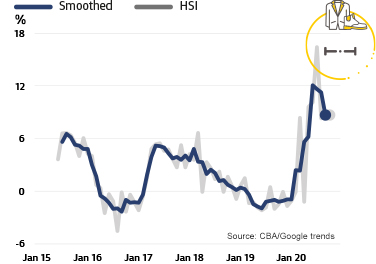
Travel Spending Intentions
- Travel spending intentions stalled in October, although they remain well off the lows seen in April. In the month, ongoing recovery was seen in visits to aquariums, camper & recreational vehicle dealers and trailer parks/camp grounds.
- Weakness remains evident in key areas such as airlines, amusement parks, hotels, motels & resorts, motor home & recreational vehicle hire, sport & rec camps, cruise lines, timeshare, tourist attractions, travel agents, car rentals and bus lines. We would expect improvement in travel spending as state borders are opened.
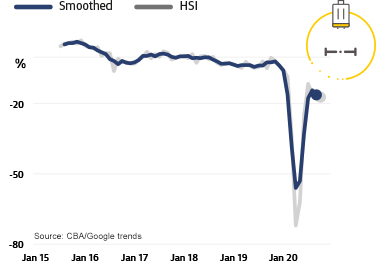
Home Buying Spending Intentions
- Home loan spending intentions improved marginally in October, but have largely been tracking sideways since the sharp recovery from the Covid-19 lows in April.
- Home loan applications have risen meaningfully over recent months, but this has been partly offset by a reduction in Google searches related to home buying.
- The November easing of monetary policy has led to a further reduction in a number of fixed mortgage rates. We expect these (very) low interest rates to continue to provide support to home buying.
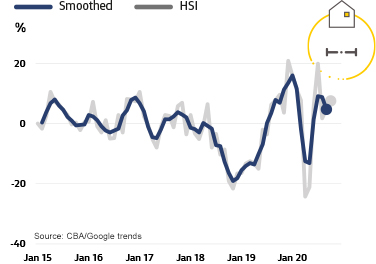
Education Spending Intentions
- Education spending intentions declined in October. While the number of transactions increased in October, Google searches were lower and the value of transactions were down on an annual basis.
- In value terms, the annual pace of education spending was lower for business and secretarial schools, secondary schools and other educational services.
- Small increases were seen in spending on colleges, universities & professional schools as well as trade & vocational schools.
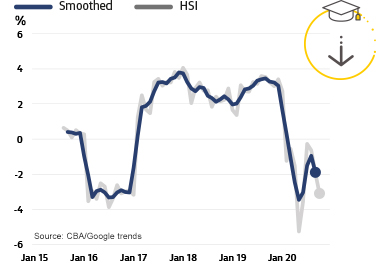
Entertainment Spending Intentions
- Entertainment spending intentions rose in October, led higher by spending in fast food, alcohol purchased to consume off-premise and recreation spending.
- Within the recreation sector good increases were seen in spending on boat rentals, bowling alleys, pay TV, digital books-movies-music & games, music stores and video arcades.
- Weakness is still evident in spending on art dealers & galleries, live music, billiard/pool establishments, dance halls/studios/schools, movie theatres, and live performance theatres.

Motor Vehicles Spending Intentions
- Motor vehicle spending intentions lost further momentum in October. While there was a small increase in new and used car transactions in October, on an annual basis Google searches, transactions and lending for motor vehicles were all lower compared with October 2019.
- Expected improvements in the housing sector should help the outlook for the motor vehicle sector. Generally, spending on motor vehicles has the highest response to changes in property prices according to research done by the RBA.
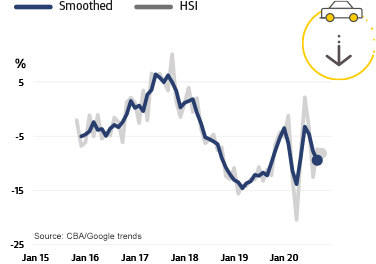
Health & Fitness Spending Intentions
- Health & fitness spending intentions declined in October, led lower by a decline in Google search activity.
- The annual rate of actual spending on Health & fitness increased in October, with gains seen in sports apparel, chiropractors, dentists, optometrists, osteopaths and podiatrists. Bicycle shops, sporting goods and golf courses also saw large rises.
- Spending remains soft for ambulances services (which is a good thing) and professional sports clubs.
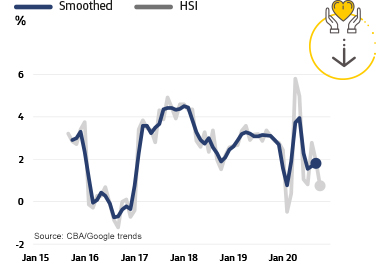
Notes for Editors:
About our monthly Household Spending Intentions series
The HSI series offers a forward-looking view by analysing actual customer behaviour from CBA’s transactions data, along with household search activity from Google Trends.
The approach focuses on Australian households and their spending intentions. Employing near real-time spending readings from CBA’s household transactions data and combining them with relevant search information from Google Trends was used to map the data results on consumer spending. Households are the dominant part of the economy and drive much of its activity and volatility, and this combination adds to insights on prospective household spending trends in the Australian economy.
Google Trends is a publically available service that enables people to explore search trends around the world. These searches provide insights into what consumers are doing/researching on the Internet and what their spending intentions are.
CBA’s Household Spending Intentions series is published on the third Tuesday of every month. To find out more about the series, visit www.commbank.com.au/spendingintentions.
Disclaimer
The information contained in this media release is published solely for information purposes and provides general market-related information, and is not intended to be an investment research report. This media release has been prepared without taking into account your objectives, financial situation (including the capacity to bear loss), knowledge, experience or needs. Before acting on the information in this media release, you should consider its appropriateness and, if necessary, seek appropriate professional or financial advice, including tax and legal advice. The data used in this media release is a combination of the CBA Data and Google Trends™ data. Google Trends is a trademark of Google LLC. The term ‘CBA Data’ refers to the proprietary data of the Commonwealth Bank of Australia ("the Bank") that is sourced from the Bank’s internal systems and may include, but is not limited to, credit card transaction data, merchant facility transaction data and applications for credit. The Bank takes reasonable steps to ensure that its proprietary data is accurate and that any opinions, conclusions or recommendations are reasonably held, or are made at the time of compilation of this media release. As the statistics take into account only the Bank’s data, no representation or warranty is made as to the completeness of the data and it may not reflect all trends in the market. All customer data used or represented in this media release is anonymous and aggregated before analysis, and is used and disclosed in accordance with the Bank’s Privacy Policy Statement.
Commonwealth Bank of Australia ABN 48 123 123 124 AFSL 234945.
Full disclosures and disclaimers.



